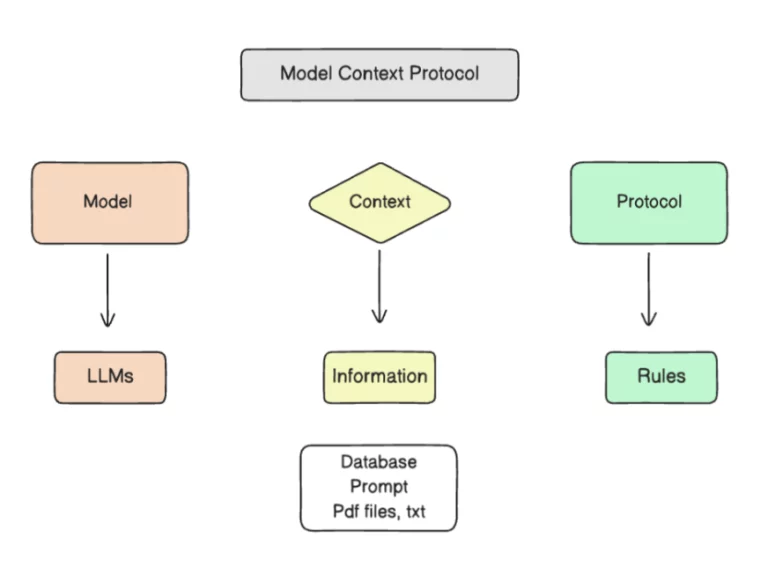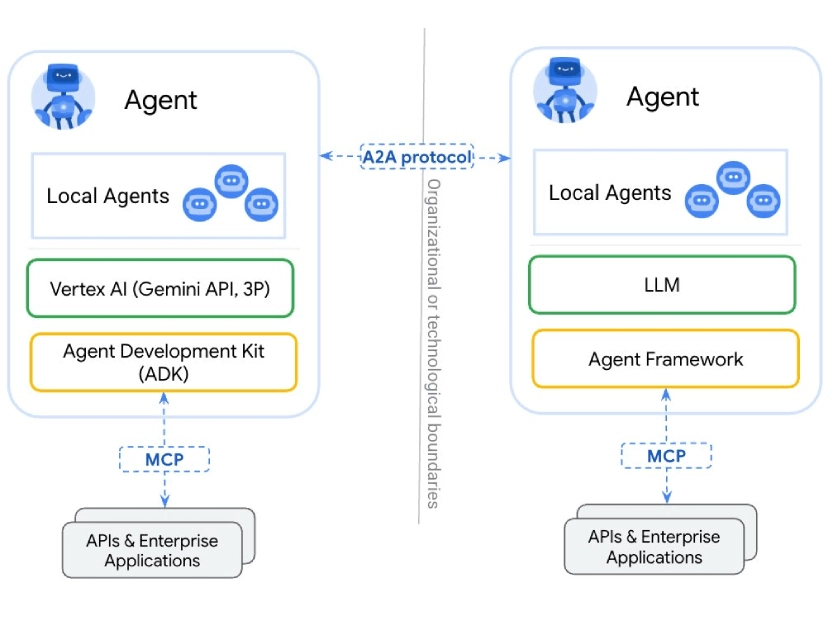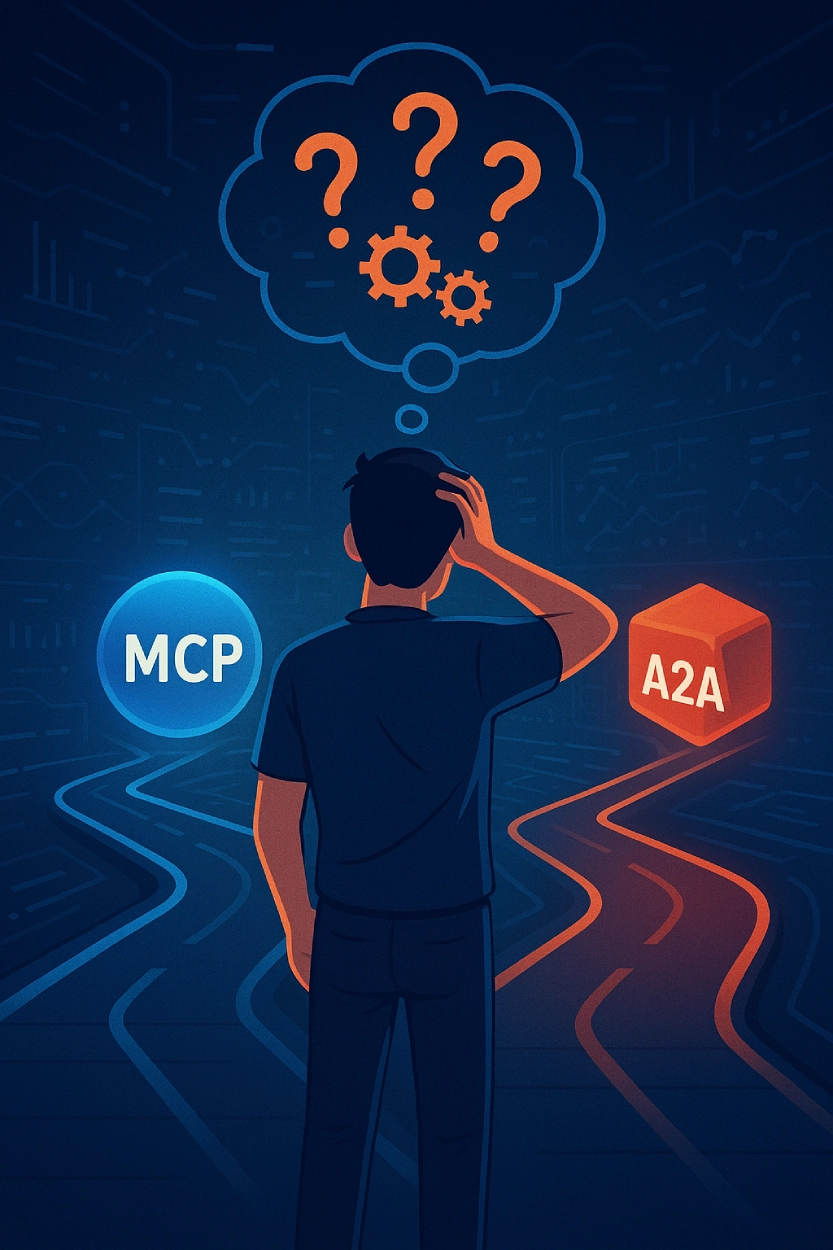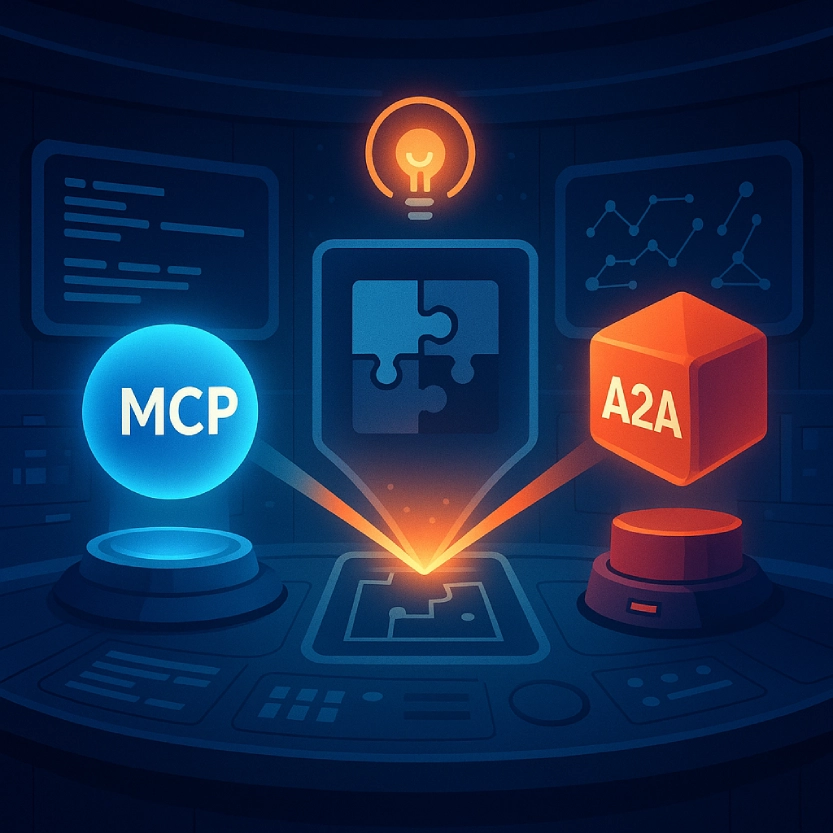A2A vs MCP: How are they Different? - Analytics Vidhya
Agent-to-Agent (A2A) and Model Context Protocol (MCP) are two prominent AI protocols that have attracted significant interest recently. While it might seem like a choice between "A2A vs MCP," they actually tackle different aspects of AI systems. This article explores what A2A and MCP are, their distinct roles in AI systems, and how they enhance each other to facilitate seamless integration within enterprise AI workflows.
Table of Contents
- What is A2A (Agent-to-Agent)?
- What is MCP (Model Context Protocol)?
- A2A vs MCP
- Key Differences
- How They Work Independently
- Integration (Better Together)
- Misconceptions
- Complementary Strengths
- Conclusion
- Frequently Asked Questions
What is A2A (Agent-to-Agent)?

Agent2Agent (A2A) is an open protocol developed by Google that standardizes the communication and collaboration among AI agents. A2A enables different AI agents, created by various vendors or running on different platforms, to establish a common language for cooperation. Through A2A, agents can share objectives, exchange context, and trigger actions securely and systematically. The protocol is specifically designed to support multi-agent workflows that operate across various clouds, applications, or services. A2A leverages familiar web standards like HTTP, which facilitates its integration into existing IT infrastructures.
For an in-depth look at how the A2A protocol functions, please refer to this article: How A2A works?
What is MCP (Model Context Protocol)?

The Model Context Protocol (MCP) was introduced by Anthropic, the parent company of Claude, to facilitate the connection of AI agents (or LLMs) to external tools. While A2A focuses on agent-to-agent communication, MCP emphasizes agent-to-resource integration. It provides a standardized method for AI models to access external data sources, knowledge bases, and services beyond their own parameters. This is why MCP is often likened to a "USB-C port" for AI applications. Before MCP, developers had to create custom integrations for each new tool or data source, resulting in a complex network of connectors. MCP streamlines this with a single open protocol, enabling any compliant data/service connector to work with any MCP-compatible agent.
To understand how MCP operates, please refer to this article: How MCP works?
For a video explanation of the MCP protocol, please watch:
A2A vs MCP ----------The following table outlines the distinct roles of A2A and MCP:
| **Aspect** | **A2A (Agent-to-Agent)** | **MCP (Model Context Protocol)** |
|---|---|---|
| **Purpose** | Facilitates connections and coordination among multiple agents (agent ↔ agent) | Enables connections between agents and external tools/data (agent ↔ resource) |
| **Key Functionality** | Facilitates task delegation among agents; allows for context and goal sharing | Enables tool and data integration; provides real-time context to agents |
| **Created by** | Google (open specification with contributions from partners) | Anthropic (open specification with adoption by multiple vendors) |
| **Ecosystem Support** | Microsoft (Azure AI Foundry, Copilot Studio), Google, Atlassian, Salesforce, ServiceNow, etc. | Microsoft (Copilot Studio), Google, OpenAI, Anthropic (Claude), Atlassian, etc. |
| **Focuses On** | Inter-agent communication: security, trust, and interoperability in agent collaboration. | Agent extensibility: uniform access to data sources and tools, maintaining current context for the agent. |
| **Analogy** | Protocol for dialogue and teamwork among AI agents. | Universal connector for linking an AI to any data/tool it requires. |
Key Differences
A2A and MCP operate in different areas of AI architecture. Here are the three main distinctions:
- Scope of Interaction: A2A links agents with each other, whereas MCP connects agents to external tools and data. Google positions A2A as a standard for agent collaboration, while Anthropic's MCP focuses on integrating agents with external services.
- Primary Function: A2A manages communication, task delegation, and state sharing between agents. MCP enhances individual agents by connecting them to external resources through a unified, tool-based interface.
- Design Principles: A2A is based on HTTP/JSON standards and supports agent discovery and secure delegation. MCP employs JSON-RPC and focuses on tool registration, data access, and real-time context provision. A2A treats agents as peers, while MCP views tools as callable services.
How They Work Independently
A2A Alone: Consider a company with specialized AI agents in areas such as finance, marketing, and scheduling. A master agent can delegate tasks like budgeting or timeline planning to other agents using A2A. Each agent then returns results through the shared protocol. Without MCP, however, each agent depends solely on its internal knowledge or pre-established connections.
MCP Alone: Imagine a support chatbot linked to live systems such as product databases, shipping APIs, and knowledge bases via MCP. This setup enables the agent to be dynamically aware and responsive in real time. Even without A2A, MCP equips it to be a tool-rich, responsive assistant. Nonetheless, it lacks the ability to coordinate with multiple agents to tackle complex or multi-step issues.
Independently, both protocols offer clear benefits. A2A facilitates modular teamwork, while MCP allows agents to gain external functionality.
Integration (Better Together)

In modern GenAI systems, A2A and MCP frequently collaborate to enable intelligent orchestration:
- Layered Cooperation: Consider MCP as the foundational layer for tool and data access, and A2A as the coordination layer that delegates tasks among agents. In a supply chain scenario, agents can retrieve inventory data, manage procurement, and oversee delivery using MCP, while A2A enables them to distribute tasks and share outcomes.
- Unified Development Experience: Microsoft's Copilot Studio exemplifies this integration. Developers can register MCP tools and connect agent workflows via A2A within a single interface. A2A manages the workflow, and MCP handles the functionality.
Misconceptions

Despite their origins from different organizations, A2A and MCP should not be seen as competing standards:
- Different Problems: A2A addresses communication, whereas MCP focuses on execution. They operate on different protocol layers.
- Complementary Functions: A2A facilitates task-sharing among agents, while MCP enables each agent to utilize tools.
- Industry-Wide Alignment: Microsoft integrates A2A in Copilot and registers MCP tools. Anthropic has open-sourced MCP and supports A2A adoption.
- No Hierarchy of Importance: Both solve essential challenges. A2A without MCP results in uninformed agents, while MCP without A2A leads to isolated agents.
The creators of both standards, Google and Anthropic, actively promote the integration of both protocols within enterprise AI workflows. Using both enables the construction of adaptable and scalable agentic systems.
Complementary Strengths

The two protocols each excel in handling specific aspects of a workflow. When used together, they complement each other effectively:
- Interoperability Extensibility: A2A connects agents across systems, while MCP makes each agent extensible. Together, they form modular, flexible ecosystems.
- Specialization Cooperation: Agents can specialize yet collaborate. MCP provides the tools, while A2A allows them to share the workload.
- Real-Time Adaptation: MCP delivers current context, while A2A reroutes tasks if conditions change. This makes systems resilient and responsive.
- Governance Observability: MCP manages tool access, while A2A governs interactions. Together, they provide traceability, compliance, and control.
Together, they bring intelligence and interoperability to generative AI systems.
Conclusion
A2A and MCP are not isolated; they are synergistic standards. Each addresses a unique challenge, but when combined, they empower agents to communicate (A2A) and act with real-world context (MCP).
Microsoft CEO Satya Nadella aptly stated:
“Open protocols like A2A and MCP are crucial for enabling the agentic web… [so] customers can develop agentic systems that are interoperable by design.”
The future of GenAI isn't about choosing one protocol over the other; it's about integrating them into our workflows. Together, they lay the groundwork for next-generation intelligent systems that are interoperable and tool-aware.
Frequently Asked Questions
Q1. What’s the difference between A2A and MCP in AI systems?A. A2A facilitates connections among multiple AI agents for communication and task delegation, while MCP connects an agent to tools and data sources for real-world functionality.
Q2. Can A2A and MCP be used together in the same system?A. Yes, they are designed to complement each other. A2A handles coordination between agents, and MCP provides tool and data access.
Q3. Who created A2A and MCP, and are they open standards?A. A2A was developed by Google, MCP by Anthropic, and both are open protocols adopted by companies like Microsoft and OpenAI.
The above is the detailed content of A2A vs MCP: How are they Different? - Analytics Vidhya. For more information, please follow other related articles on the PHP Chinese website!

Hot AI Tools

Undresser.AI Undress
AI-powered app for creating realistic nude photos

AI Clothes Remover
Online AI tool for removing clothes from photos.

Undress AI Tool
Undress images for free

Clothoff.io
AI clothes remover

Video Face Swap
Swap faces in any video effortlessly with our completely free AI face swap tool!

Hot Article

Hot Tools

Notepad++7.3.1
Easy-to-use and free code editor

SublimeText3 Chinese version
Chinese version, very easy to use

Zend Studio 13.0.1
Powerful PHP integrated development environment

Dreamweaver CS6
Visual web development tools

SublimeText3 Mac version
God-level code editing software (SublimeText3)

Hot Topics
 1677
1677
 14
14
 1431
1431
 52
52
 1334
1334
 25
25
 1280
1280
 29
29
 1257
1257
 24
24
 How to Build MultiModal AI Agents Using Agno Framework?
Apr 23, 2025 am 11:30 AM
How to Build MultiModal AI Agents Using Agno Framework?
Apr 23, 2025 am 11:30 AM
While working on Agentic AI, developers often find themselves navigating the trade-offs between speed, flexibility, and resource efficiency. I have been exploring the Agentic AI framework and came across Agno (earlier it was Phi-
 OpenAI Shifts Focus With GPT-4.1, Prioritizes Coding And Cost Efficiency
Apr 16, 2025 am 11:37 AM
OpenAI Shifts Focus With GPT-4.1, Prioritizes Coding And Cost Efficiency
Apr 16, 2025 am 11:37 AM
The release includes three distinct models, GPT-4.1, GPT-4.1 mini and GPT-4.1 nano, signaling a move toward task-specific optimizations within the large language model landscape. These models are not immediately replacing user-facing interfaces like
 How to Add a Column in SQL? - Analytics Vidhya
Apr 17, 2025 am 11:43 AM
How to Add a Column in SQL? - Analytics Vidhya
Apr 17, 2025 am 11:43 AM
SQL's ALTER TABLE Statement: Dynamically Adding Columns to Your Database In data management, SQL's adaptability is crucial. Need to adjust your database structure on the fly? The ALTER TABLE statement is your solution. This guide details adding colu
 Rocket Launch Simulation and Analysis using RocketPy - Analytics Vidhya
Apr 19, 2025 am 11:12 AM
Rocket Launch Simulation and Analysis using RocketPy - Analytics Vidhya
Apr 19, 2025 am 11:12 AM
Simulate Rocket Launches with RocketPy: A Comprehensive Guide This article guides you through simulating high-power rocket launches using RocketPy, a powerful Python library. We'll cover everything from defining rocket components to analyzing simula
 DeepCoder-14B: The Open-source Competition to o3-mini and o1
Apr 26, 2025 am 09:07 AM
DeepCoder-14B: The Open-source Competition to o3-mini and o1
Apr 26, 2025 am 09:07 AM
In a significant development for the AI community, Agentica and Together AI have released an open-source AI coding model named DeepCoder-14B. Offering code generation capabilities on par with closed-source competitors like OpenAI
 The Prompt: ChatGPT Generates Fake Passports
Apr 16, 2025 am 11:35 AM
The Prompt: ChatGPT Generates Fake Passports
Apr 16, 2025 am 11:35 AM
Chip giant Nvidia said on Monday it will start manufacturing AI supercomputers— machines that can process copious amounts of data and run complex algorithms— entirely within the U.S. for the first time. The announcement comes after President Trump si
 One Prompt Can Bypass Every Major LLM's Safeguards
Apr 25, 2025 am 11:16 AM
One Prompt Can Bypass Every Major LLM's Safeguards
Apr 25, 2025 am 11:16 AM
HiddenLayer's groundbreaking research exposes a critical vulnerability in leading Large Language Models (LLMs). Their findings reveal a universal bypass technique, dubbed "Policy Puppetry," capable of circumventing nearly all major LLMs' s
 Guy Peri Helps Flavor McCormick's Future Through Data Transformation
Apr 19, 2025 am 11:35 AM
Guy Peri Helps Flavor McCormick's Future Through Data Transformation
Apr 19, 2025 am 11:35 AM
Guy Peri is McCormick’s Chief Information and Digital Officer. Though only seven months into his role, Peri is rapidly advancing a comprehensive transformation of the company’s digital capabilities. His career-long focus on data and analytics informs




